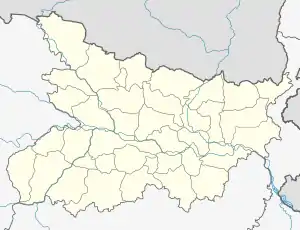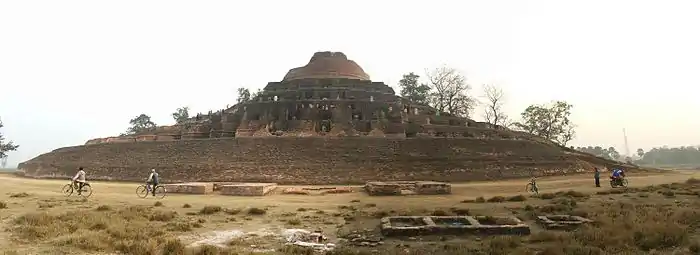Kesaria
Kesariya is a town in the district of East Champaran, in the Indian state of Bihar. It is the site of a stupa built by the Mauryan king Ashoka.
Kesariya
केसरिया Kasariya | |
|---|---|
Town | |
| Nickname(s): Kesaputta | |
 Kesariya Location in Bihar, India  Kesariya Kesariya (Bihar) | |
| Coordinates: 26.334192°N 84.854820°E | |
| Country | |
| State | Bihar |
| District | East Champaran |
| Government | |
| • Type | State Government |
| • Body | Bihar |
| Elevation | 45 m (148 ft) |
| Languages | |
| • Official | languageHindi, Urdu, Bhojpuri |
| Time zone | UTC+5:30 (IST) |
| PIN | 845424 |
Geography
It is near Rampur Khajuria. The nearest villages are Noori Mohalla Trilokwa & Trilokwa (3.5 km),Kushar Saikh Toli (4 km), Phultakiya (3 km), Baisakhawa (2 km), Ramgadhwa (4 km), Tajpur (6 km), Bairiya (6 km), Bathana (5 km), Nyagaw (4 km).There are also two mosques in the town and nearest railway Station is Chakia about 25km.
History
Ancient Kesariya (formally known as Kesaputta) was a republic ruled by Kalamas, later annexed by its monarchical neighbor Kosala.
Legend
Alara Kalama, Buddha's teacher before enlightenment, is said to have been from Kesaputta. Buddha is said to have had a direct connection with Kesaputta. According to Jataka tales, Buddha had ruled this place as a Chakravartin Raja in his previous birth. During one of Buddha's visits to Kesaputta, he gave an essential discourse, the celebrated Kessaputtiya Sutta, popularly known as Kalama Sutta.
The local people call this Stupa Devala, meaning "the house of God." Before the excavation of this, they believed that inside it there is a temple of Shiva which was built by King Bhema and contain a lot of tresures.
Kesariya Stupa

| Pilgrimage to |
| Buddha's Holy Sites |
|---|
 |
| The Four Main Sites |
| Four Additional Sites |
| Other Sites |
|
| Later Sites |
Initially constructed as a mud stupa, it gained its present structure in the Maurya, Sunga and Kushana period. The stupa dates between 200 AD and 750 AD and may have been associated with the 4th-century ruler, Raja Chakravarti.[1] Kesariya Stupa is 104 feet high.
Huien Tsang mentions having seen the grand Stupa in Kia-shi-po-lo (Kesariya) but it was deserted and overgrown.
The Kesariya stupa was discovered in 1958 during an excavation led by Archaeologist KK Muhammed of Archaeological Survey of India (ASI).
A 1998 excavation of the area surrounding the stupa uncovered significant items, such as Islamic coins, arrowheads, copper and terracotta items, earthen lamps, decorated bricks, etc. Some images of Buddha, in ‘Bhoomi Sparsh Mudra’ and other sitting postures, were found.
Transport
Transport and accommodation are available from the state capital, Patna, for visit to the Bodh circuit (Bodhgaya, Rajgir, Nalanda, Vaishali, Kesaria, Lumbini, Kushinagar, Sarnath), Jain Circuit (Rajgir, Pawapuri), and Sikh Circuit in Bihar.[2]
Climate
| Climate data for Kesaria | |||||||||||||
|---|---|---|---|---|---|---|---|---|---|---|---|---|---|
| Month | Jan | Feb | Mar | Apr | May | Jun | Jul | Aug | Sep | Oct | Nov | Dec | Year |
| Record high °C (°F) | 23.1 (73.6) |
25.7 (78.3) |
31.9 (89.4) |
35.3 (95.5) |
37.5 (99.5) |
35.2 (95.4) |
32.6 (90.7) |
32.1 (89.8) |
32 (90) |
31.5 (88.7) |
28.4 (83.1) |
24.5 (76.1) |
37.5 (99.5) |
| Record low °C (°F) | 9.5 (49.1) |
11.1 (52.0) |
16 (61) |
21.1 (70.0) |
24.9 (76.8) |
26.1 (79.0) |
25.7 (78.3) |
26 (79) |
25.4 (77.7) |
21.7 (71.1) |
14.4 (57.9) |
10.2 (50.4) |
9.5 (49.1) |
| Source: [3] | |||||||||||||
References
- "Kesaria Buddhsit Pilgrimage Tour,Buddhist Pilgrimage Tour in Kesaria India,Kesaria Buddhist Pilgrimage Tour in Bihar,Book for a Buddhist Pilgrimage Tour Kesaria". www.buddhist-pilgrimage.com. Retrieved 2019-01-20.
- Bihar Tourism
- "Kesaria, Bihar Weather".
